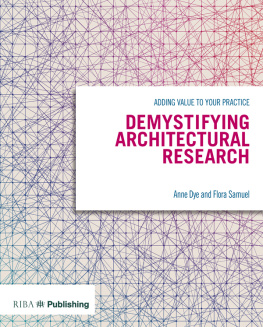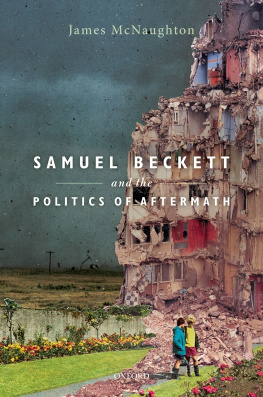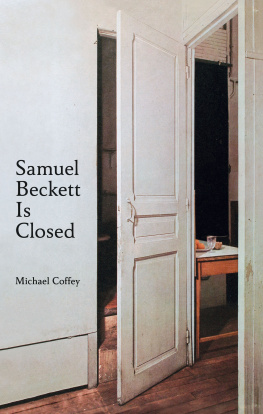Flora Samuel - Demystifying Architectural Research
Here you can read online Flora Samuel - Demystifying Architectural Research full text of the book (entire story) in english for free. Download pdf and epub, get meaning, cover and reviews about this ebook. year: 2019, publisher: RIBA Publishing, genre: Politics. Description of the work, (preface) as well as reviews are available. Best literature library LitArk.com created for fans of good reading and offers a wide selection of genres:
Romance novel
Science fiction
Adventure
Detective
Science
History
Home and family
Prose
Art
Politics
Computer
Non-fiction
Religion
Business
Children
Humor
Choose a favorite category and find really read worthwhile books. Enjoy immersion in the world of imagination, feel the emotions of the characters or learn something new for yourself, make an fascinating discovery.
- Book:Demystifying Architectural Research
- Author:
- Publisher:RIBA Publishing
- Genre:
- Year:2019
- Rating:3 / 5
- Favourites:Add to favourites
- Your mark:
- 60
- 1
- 2
- 3
- 4
- 5
Demystifying Architectural Research: summary, description and annotation
We offer to read an annotation, description, summary or preface (depends on what the author of the book "Demystifying Architectural Research" wrote himself). If you haven't found the necessary information about the book — write in the comments, we will try to find it.
Demystifying Architectural Research — read online for free the complete book (whole text) full work
Below is the text of the book, divided by pages. System saving the place of the last page read, allows you to conveniently read the book "Demystifying Architectural Research" online for free, without having to search again every time where you left off. Put a bookmark, and you can go to the page where you finished reading at any time.
Font size:
Interval:
Bookmark:

Demystifying Architectural Research
RIBA Enterprises Ltd, 2015
Published by RIBA Publishing, part of RIBA Enterprises Ltd, The Old Post Office, St Nicholas Street, Newcastle upon Tyne, NE1 1RH
ISBN 978 1 85946 578 3
Stock code 83983
The right of RIBA Enterprises Ltd to be identified as the Author of this Work has been asserted in accordance with the Copyright, Designs and Patents Act 1988 sections 77 and 78.
All rights reserved. No part of this publication may be reproduced, stored in a retrieval system, or transmitted, in any form or by any means, electronic, mechanical, photocopying, recording or otherwise, without prior permission of the copyright owner.
British Library Cataloguing-in-Publication Data
A catalogue record for this book is available from the British Library.
Publisher: Steven Cross
Commissioning Editor: Sarah Busby
Production: Richard Blackburn
Designed and Typeset by Gavin Ambrose
Printed and bound by CPI Antony Rowe in Chippenham, Great Britain
Cover design: Karen Wilks
Cover image istock.com/ctriaplus1
While every effort has been made to check the accuracy and quality of the information given in this publication, neither the Author nor the Publisher accept any responsibility for the subsequent use of this information, for any errors or omissions that it may contain, or for any misunderstandings arising from it.
RIBA Publishing is part of RIBA Enterprises Ltd.
www.ribaenterprises.com
Fionn Stevenson of the University of Sheffield
Sarah Wigglesworth of Sarah Wigglesworth Architects
Anne Thorne of Anne Thorne Architects LLP
Irena Bauman of Bauman Lyons Architects
Merritt Bucholz of Bucholz McEvoy Architects
Chris Halligan of Steven George & Partners LLP
Ian Standen of Stride Treglown
Julia Udall of the University of Sheffield
Richard Cottrell, Cottrell & Vermeulen Architecture
Jane Burnside of Jane D Burnside Architects
John Sampson of URBED
Mark Parsons of Studio Polpo
Rupert Daly of Collective Architecture
Stephen Walker of the University of Sheffield
Tony Broomhead of OS31
Helen Stratford of Helen Stratford Architects
Chris Loyn of Loyn & Co Architects
Patrick Lynch of Lynch Architects
Gillian Horn of Penoyre & Prasad
Anne Dye of the Royal Institute of British Architects
Gordon Gibb of Gibb Architects Ltd
Paul Iddon of Agency Spring
Walter Menteth of Walter Menteth Architects

The School of Architecture in the University of Sheffield is known for the excellence of its research and teaching as well as its strong links to practice. It is leading the development of Architectural Research Practice (ARP) in the UK because of its long-term commitment to social and environmental values. The development of evaluative techniques is key to understanding where and how best to use resources to improve the quality of our built environment. Evaluative techniques are also vital for demonstrating the contribution of our profession to society and to our economy. There is much to gain from the development of architectures knowledge base, but it requires a cultural shift towards collaboration, not only between practice, academia and clients, but also with other disciplines and organisations beyond architectures traditional concerns. Central to this is the development of a shared language, the fundamental aim of this book.
www.sheffield.ac.uk/architecture
Twitter: @SSoA_news
Reading this book is an exciting voyage of discovery for any architect. The discovery that not only is it possible for a practice to gain a more in-depth understanding about a topic of personal or practice interest, but that many of us are already undertaking elementary research in our practices, unaware that this is what we are doing.
Unaware that with the right approach, collaboration with academia or other more experienced practices, or simply by trial and error, we may access funding which could elevate the innovative and stimulating original elements of the work which we enjoy. This, in turn, could create a unique marketing advantage, a USP which can draw clients towards us, enabling us to attract better more profitable projects.
The evidence is here that published and shared research, whether that research is done by a one man band or a large and established firm, can garner intellectual status, client reassurance and peers respect for a practice. It furthers the knowledge of the whole profession and can be a stepping stone to a more fulfilling and intellectual work life.
This easy to access, masterly and long awaited book by two of the architecture professions leading research gurus, Anne Dye and Flora Samuel, uses case studies from a wide range of practices which tell their research stories first hand. It splits into the different genres of research to show us all the methods, the joys and the gains to be had: from more profit though commercial specialism, to a more altruistic contribution through sharing cultural and social knowledge.
The research projects themselves are an inspirational and uplifting read but, more than this, a clear message is spelled out throughout: do more research, indulge your passion, find funding, share your methods and results and your work will repay you many fold.
Lets get researching!
Jane Duncan
RIBA President 2015
This book aims to help architects in practice to use research as a means to get ahead in business, to access new funding streams almost 80 billion is currently available via the European Horizon 2020 programme and to advance the knowledge economy of our field. We believe research to be key to helping architects regain some of the professional standing that has been eroded over time as D. Kirk Hamilton and David H. Watkins have observed:
It still stings: you are a respected architect, youve spent a great deal of effort attempting to convince your valued client about something, and you believed you were right Why does your client, who has worked with you before, not seem to trust your professional opinions?
In writing this book we hoped to set out a compelling argument to show how engaging with research can help a client to win work, make a stronger case for fees and convince clients that the skills of an architect are of utmost importance to their project, while providing tools that will help them to design better buildings. Not only does research bring the business benefits of proven expertise and a unique selling point, it also brings great satisfaction as the architects who have contributed case studies to this book have shown.
Architecture is built on values that remain largely tacit. This puts the profession at a disadvantage when communicating with a public that have little understanding of what an architect does; how can someone value the work that an architect does if they dont know what that work is? Countering this there is a growing body of practices that are using research to give clients evidence as we all know, clients tend to like evidence about why design makes a difference, and of how the practice is continually improving what they do. They are using research to define their brand, offer new services and improve how they work. At the same time they reap the rewards in terms of new or strengthened revenue streams. Many are small- to medium-sized practices with a strong presence in the regions, where business isnt bolstered by Londons construction boom; practices like Architype, URBED and Bauman Lyons Architects have all contributed case studies. This book is for exactly this type of small- to medium-sized practice the practices that make up the majority of architectural offices in the UK so that they too can start to take advantage of the business benefits that research can bring.
Font size:
Interval:
Bookmark:
Similar books «Demystifying Architectural Research»
Look at similar books to Demystifying Architectural Research. We have selected literature similar in name and meaning in the hope of providing readers with more options to find new, interesting, not yet read works.
Discussion, reviews of the book Demystifying Architectural Research and just readers' own opinions. Leave your comments, write what you think about the work, its meaning or the main characters. Specify what exactly you liked and what you didn't like, and why you think so.












